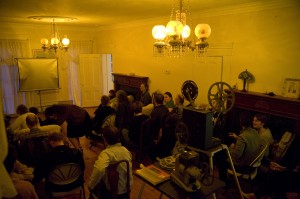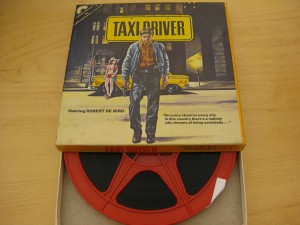NHF Summer Symposium
August 31st, 2009
Last month the HFA’s Conservation Center staff attended the annual Summer Symposium at Northeast Historic Film in Bucksport, ME. The theme of this year’s symposium was Ways of Watching.
Papers were delivered on topics as diverse as watching and interpreting the home movies of strangers, presenting films at a department store in the early days of cinema, and viewing films in classrooms.
This was a great opportunity for the HFA to present some films from the Howard E. Burr Collection. We realized that, although the scholars and archivists at the symposium were very interested in watching films, some may not have ever seen a film projected, as many researchers access film through digital or video copies of the actual film. Most had probably not watched films at the home of a collector, and many had probably not seen the films I chose to project for them.
We decided to set up a screening night that would roughly represent a typical screening night in the home of a film collector. We didn’t want the screening to take place at the same venue as the symposium, which was held in NHF’s movie theatre, because the nature of the event demanded a more intimate atmosphere. A local participant in the symposium generously volunteered to host the screening at her home, which was perfect.

Not all collectors present their screenings in the same way, but there tends to be a common wish to “put on a show,” frequently aping the habits of the cinema during Hollywood’s Golden Age. Rare is the screening of only one title. “Doc” Burr’s daughter described screening nights at his home, which represent the habits of many others: “He was big on showing newsreels, a travelogue, previews of coming attractions, or cartoons (sometimes one of each!) preceding the feature.” For the NHF screening night we attempted a similar program (although far shorter).
We presented film on 3 small gauge formats common to the US home cinema market: 16mm, 8mm, and super 8. First, an 8mm reduction print of a silent Mack Sennett comedy, The Campus Carmen (1928). Next up, New England Holiday!, a 16mm short, silent travelogue from the 1940s about vacationing in New England. In keeping with tradition, we moved to a cartoon, Farmer Gray in English Channel Swim (1925), shown in 16mm. The “feature” finale was a super 8 condensed reduction print of Taxi Driver (1976), with mag sound.
 It was not unusual for studios to release condensed versions of features for the home market. Most common are the 8mm or super 8 silent versions that take a feature film and reduce it to its best 5 minutes, using inter-titles to explain the story.
It was not unusual for studios to release condensed versions of features for the home market. Most common are the 8mm or super 8 silent versions that take a feature film and reduce it to its best 5 minutes, using inter-titles to explain the story.
This version of Taxi Driver was a little different. The tale was cut down to the story of Travis, the pimp, and Iris (the teenage prostitute). A narrator is employed to describe some gaps in the story. “Travis Bickle has decided to take revenge against the pimp.” The original sound from the film is retained. “You lookin’ at me?” Using only the scenes of sex and violence, the film is reduced to an exploitation version of itself.
The screening was a perfect coda to the symposium. Everyone welcomed the opportunity to sit and watch films projected from a few feet behind them, the unfamiliar noise of the projector becoming part of the show. People who were not familiar with these “home versions” of feature films were fascinated by them. The woman who had not seen Taxi Driver had her fears confirmed, but has lived to tell the tale.
Upon returning home, we discovered quite a number of these super 8 sound condensed films, and hope to put a screening together for the public. Keep an eye on our calender for details.
